This is an old revision of this page, as edited by The Nut (talk | contribs) at 11:52, 27 June 2010 (External links, caps). The present address (URL) is a permanent link to this revision, which may differ significantly from the current revision.
Revision as of 11:52, 27 June 2010 by The Nut (talk | contribs) (External links, caps)(diff) ← Previous revision | Latest revision (diff) | Newer revision → (diff) This article is about the country in northern Europe. For other uses, see Finland (disambiguation).| This article may be too long to read and navigate comfortably. Consider splitting content into sub-articles, condensing it, or adding subheadings. Please discuss this issue on the article's talk page. (January 2010) |
65°N 027°E / 65°N 27°E / 65; 27
| Republic of FinlandSuomen tasavalta Template:Fi icon Error: {{Lang}}: text has italic markup (help) Template:Sv icon | |
|---|---|
 Flag
Flag
 Coat of arms
Coat of arms
| |
| Anthem: Error: {{Lang}}: text has italic markup (help) (Finnish) Error: {{Lang}}: text has italic markup (help) (Swedish) "Our Land" | |
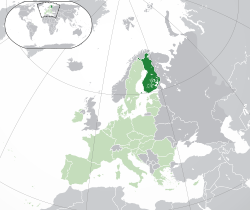 Location of Finland (dark green) Location of Finland (dark green)– in Europe (light green & dark grey) | |
| Capitaland largest city | Helsinki |
| Official languages | Finnish, Swedish |
| Recognised regional languages | Saami |
| Religion | Lutheran |
| Demonym(s) | Finns, Finnish |
| Government | Semi-presidential republic |
| • President | Tarja Halonen |
| • Prime Minister | Mari Kiviniemi |
| Independence from Russian Empire | |
| • Autonomy | March 29, 1809 |
| • Declared | December 6, 1917 |
| • Recognized | January 4, 1918 |
| Area | |
| • Total | 338,424 km (130,666 sq mi) (64th) |
| • Water (%) | 10 |
| Population | |
| • 2010 estimate | 5,359,538 (111th) |
| • 2000 census | 5,180,000 |
| • Density | 16/km (41.4/sq mi) (201st) |
| GDP (PPP) | 2009 estimate |
| • Total | $179.598 billion |
| • Per capita | $33,556 |
| GDP (nominal) | 2009 estimate |
| • Total | $238.128 billion |
| • Per capita | $44,491 |
| Gini (2000) | 26.9 low inequality |
| HDI (2007) | Error: Invalid HDI value (12th) |
| Currency | Euro (€)¹ (EUR) |
| Time zone | UTC+2 (EET) |
| • Summer (DST) | UTC+3 (EEST) |
| Drives on | Right |
| Calling code | 358 |
| ISO 3166 code | FI |
| Internet TLD | .fi, .ax ² |
| |
Finland (pronounced /ˈfɪnlənd/), officially the Republic of FinlandFinnish: Suomi; Swedish: Finland, is a Nordic country situated in the Fennoscandian region of Northern Europe. It is bordered by Sweden on the west, Norway on the north and Russia on the east, while Estonia lies to its south across the Gulf of Finland.
Around 5.4 million people reside in Finland, with the majority concentrated in the southern part of the country. It is the eighth largest country in Europe in terms of area and the most sparsely populated country in the European Union. Finland is a parliamentary republic with a central government based in Helsinki and local governments in 342 municipalities. A total of about one million residents live in the Greater Helsinki area (which includes Helsinki, Espoo, Kauniainen and Vantaa), and a third of the country's GDP is produced there. Other larger cities include Tampere, Turku, Oulu, Jyväskylä, Kuopio and Lahti.
Finland was historically a part of Sweden and from 1809 an autonomous Grand Duchy within the Russian Empire. Finland's declaration of independence from Russia in 1917 was followed by a civil war, wars against the Soviet Union and Nazi Germany, and a period of official neutrality during the Cold War. Finland joined the United Nations in 1955, the OECD in 1969, the European Union in 1995, and the eurozone since its beginning. Finland has been ranked the second most stable country in the world, in a survey based on social, economic, political and military indicators.
Finland was a relative latecomer to industrialization, remaining a largely agrarian country until the 1950s. Thereafter, economic development was rapid, and the country reached the world's top income levels in the 1970s. Between 1970 and 1990, Finland built an extensive welfare state. In the aftermath of the country's severe depression in the early 1990s, successive governments have changed the Finnish economic system through some privatisation, deregulation and tax cuts.
Finland is well placed in international comparisons of national performance such as the share of high-technology manufacturing and health care. The country is ranked 1st in the 2009 Legatum Prosperity rating, which is based on economical performance and quality of life.
Etymology
The name Suomi (Finnish for "Finland") has uncertain origins, but a candidate for a cognate is the Proto-Baltic word *zeme, meaning "land". In addition to the close relatives of Finnish (the Baltic-Finnic languages), this name is also used in the Baltic languages Latvian and Lithuanian. According to an earlier theory the name was derived from suomaa (fen land) or suoniemi (fen cape).
The Swedish-language name Finland has resemblance with the North Germanic placenames Finnmark, Finnveden and hundreds of other toponyms starting with Fin(n) in Sweden and Norway. Some of these names are obviously derived from finnr, a Germanic word for a wanderer/finder and thus supposedly meaning nomadic "hunter-gatherers" or slash and burn agriculturists as opposed to the Germanic sedentary farmers and seafaring traders and pirates. The term "Finn" often refers to Sami people, too. Finn was used to refer to the people of Finland Proper after the 15th century, when the church appointed a bishop — who became one of the most powerful men in the province — over the whole area corresponding roughly to today's Finland. The fact that there was no other ecclesiastical authority of the same level, coupled with the bishop's temporal authority, engendered a sense of "the Finns" belonging to one geographical area over which the name spread from the 15th century onwards to refer to the people of the entire country.
Among the first documents to mention "a land of the Finns" are two rune-stones. There is one in Söderby, Sweden, with the inscription finlont (U 582) and one in Gotland, a Swedish island in the Baltic Sea, with the inscription finlandi (G 319), dating from the 11th century.
History
Main article: History of Finland
Prehistory
According to archaeological evidence, the area now comprising Finland was settled at the latest around 8500 BCE during the Stone Age as the ice sheet of the last ice age receded. The artifacts the first settlers left behind present characteristics that are shared with those found in Estonia, Russia and Norway. The earliest people were hunter-gatherers, using stone tools. There is also evidence of carved stone animal heads. The first pottery appeared in 3000 BCE when settlers from the East brought in the Comb Ceramic culture. The arrival of the Corded Ware culture in southern coastal Finland between 3000–2500 BCE coincided with the start of agriculture. Even with the introduction of agriculture, hunting and fishing continued to be important parts of the subsistence economy.
The Bronze Age (1500–500 BCE) and Iron Age (500 BCE–1200 CE) were characterised by extensive contacts with other cultures in the Fennoscandian and Baltic regions. There is no consensus on when Finno-Ugric languages and Indo-European languages were first spoken in the area of contemporary Finland.
In the beginning of 9th century the inhabited area of Finnish tribes was bordered by:
- White Sea, in the north
- Northmen, in the west behind Scandinavian Mountains
- Swedes & Goths, in the southern tip of Scandinavian Peninsula
- Baltic Sea
- Estland, to the south of Gulf of Finland
- Slavonic tribes, in the Novgorod surroundings and further in the south
- Kingdom of Chazars, Morduines, White Bulgarians and Bashkirs who lived in the Volga watershed area.
Swedish era
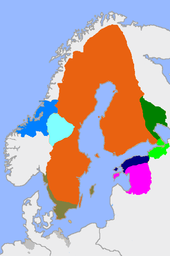
Swedish-speaking settlers arrived in the coastal regions during the medieval time. Swedish kings established their rule in 1249. The area of present-day Finland became a fully consolidated part of the Swedish kingdom. Swedish became the dominant language of the nobility, administration and education; Finnish was chiefly a language for the peasantry, clergy and local courts in predominantly Finnish-speaking areas.
During the Protestant Reformation, the Finns gradually converted to Lutheranism. In the 16th century, Mikael Agricola published the first written works in Finnish. The first university in Finland, The Royal Academy of Turku, was established in 1640. Finland suffered a severe famine in 1696–1697, and almost one third of the population died. In the 18th century, wars between Sweden and Russia led to the occupation of Finland twice by Russian forces, wars known to the Finns as the Greater Wrath (1714–1721) and the Lesser Wrath (1742–1743). By this time Finland was the predominant term for the whole area from the Gulf of Bothnia to the Russian border.
Russian Empire era
Main article: Grand Duchy of Finland See also: Finland's language strife and Russification of FinlandOn March 29, 1809, after being taken over by the armies of Alexander I of Russia in the Finnish War, Finland became an autonomous Grand Duchy in the Russian Empire until the end of 1917. During the Russian era, the Finnish language started to gain recognition. From the 1860s onwards, a strong Finnish nationalist movement known as the Fennoman movement grew. Milestones included the publication of what would become Finland's national epic – the Kalevala – in 1835, and the Finnish language's achieving equal legal status with Swedish in 1892.
The Finnish famine of 1866–1868 killed 15% of the population, making it one of the worst famines in European history. The famine led the Russian Empire to ease financial regulations, and investment rose in following decades. Economic and political development was rapid. The GDP per capita was still a half of the United States and a third of Great Britain.
In 1906, universal suffrage was adopted in the Grand Duchy of Finland. However, the relationship between the Grand Duchy and the Russian Empire soured when the Russian government made moves to restrict Finnish autonomy. For example, the universal suffrage was, in practice, virtually meaningless, since the tsar did not have to approve any of the laws adopted by the Finnish parliament. Desire for independence gained ground, first among radical liberals and socialists.
Civil war and early independence
Main articles: Finland's Declaration of Independence and Finnish Civil WarBackground
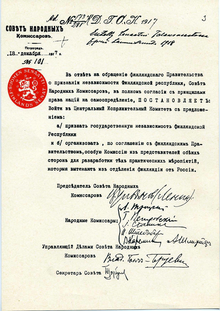
After the February Revolution the position of Finland as part of the Russian Empire was questioned, mainly by Social Democrats. Since the head of state was the Czar of Russia, it was not clear who was the chief executive of Finland after the revolution. The parliament, controlled by social democrats, passed the so-called Power Law, which would give the highest authority to the parliament. This was rejected by the Russian Provisional Government and by the right wing parties in Finland. The Provisional Government dissolved the parliament by force, which the social democrats considered illegal, since the right to do so was stripped from the Russians by the Power Law.
New elections were conducted, in which right wing parties won a slim majority. Some social democrats refused to accept the result and still claimed that the dissolution of the parliament (and thus the ensuing elections) were extralegal. The two nearly equally powerful political blocs, the right wing parties and the social democratic party, were highly antagonized.
The October Revolution in Russia changed the game anew. Suddenly, the right-wing parties in Finland started to reconsider their decision to block the transfer of highest executive power from the Russian government to Finland, as radical socialists took power in Russia. Rather than acknowledge the authority of the Power Law of a few months earlier, the right-wing government declared independence.
War
On January 27, 1918, the official starting shots to the war were fired in two simultaneous events. The government started to disarm the Russian forces in Pohjanmaa , and the Social Democratic Party staged a coup. The latter succeeded in controlling southern Finland and Helsinki, but the legal government continued in exile from Vaasa. This sparked the brief but bitter civil war. The Whites, who were supported by Imperial Germany, prevailed over the Reds, supported by Bolshevist Russia. After the war tens of thousands of Reds and suspected sympathizers were interned in camps, where thousands died by execution or from malnutrition and disease. Deep social and political enmity was sown between the Reds and Whites and would last until the Winter War and beyond. The civil war and activist expeditions to the Soviet Union strained Eastern relations.
New republic
After a brief flirtation with monarchy, Finland became a presidential republic, with Kaarlo Juho Ståhlberg elected as its first president in 1919. The Finnish–Russian border was determined by the Treaty of Tartu in 1920, largely following the historic border but granting Pechenga (Template:Lang-fi) and its Barents Sea harbour to Finland. Finnish democracy did not see any more Soviet coup attempts and survived the anti-Communist Lapua Movement. The relationship between Finland and the Soviet Union was tense. Germany's relations with Finland were also not good. Military was trained in France instead, and relations to Western Europe and Sweden were strengthened.
In 1917 the population was 3 million. Credit-based land reform was enacted after the civil war, increasing the proportion of capital-owning population. About 70% of workers were occupied in agriculture and 10% in industry. The largest export markets were the United Kingdom and Germany. The Great Depression in the early 1930s was relatively light in Finland.
World War II
Main article: Military history of Finland during World War II
During World War II, Finland fought the Soviet Union twice: in the Winter War of 1939–40 after the Soviet Union had attacked Finland; and in the Continuation War of 1941–44, following Operation Barbarossa, in which Germany invaded the Soviet Union. For 872 days, German and Finnish armies besieged Leningrad, the Soviet Union's second largest city. Finland did not play a role in the siege, but rather held positions northwest and north of the city for geographical reasons. The siege of Leningrad resulted in the deaths of some one million of the city's inhabitants. After fighting a major Soviet offensive in June/July 1944 to a standstill, Finland reached an armistice with the Soviet Union. This was followed by the Lapland War of 1944–45, when Finland forced the Germans out of northern Finland.
The treaties signed in 1947 and 1948 with the Soviet Union included Finnish obligations, restraints and reparations – as well as further Finnish territorial concessions begun in the Moscow Peace Treaty of 1940. As a result of the two wars, Finland was forced to cede most of Finnish Karelia, Salla and Petsamo, which amounted to ten percent of its land area and twenty percent of its industrial capacity, including the ports of Vyborg (Viipuri) and ice-free Liinakhamari (Liinahamari). Almost the whole population, some 400,000 persons, fled these areas. Finland was never occupied by Soviet forces and retained its independence, however at a loss of about 93 000 soldiers killed, by proportion the third-highest loss rate in World War II.
Finland had to reject Marshall aid. However, the United States provided secret development aid and helped the still non-communist Social Democratic Party in hopes of preserving Finland's independence. Establishing trade with the Western powers, such as the United Kingdom, and the reparations to the Soviet Union caused Finland to transform itself from a primarily agrarian economy to an industrialised one. For example, the Valmet corporation was founded to create materials for war reparations. Even after the reparations had been paid off, Finland – poor in certain resources necessary for an industrialized nation (such as iron and oil) – continued to trade with the Soviet Union in the framework of bilateral trade.
Cold War
In 1950 half of the Finnish workers were occupied in agriculture and a third lived in urban areas. The new jobs in manufacturing, services and trade quickly attracted people to the towns. The average number of births per woman declined from a baby boom peak of 3.5 in 1947 to 1.5 in 1973. When baby-boomers entered the workforce, the economy did not generate jobs fast enough, and hundreds of thousands emigrated to the more industrialized Sweden, with emigration peaking in 1969 and 1970. The 1952 Summer Olympics brought international visitors. Finland took part in trade liberalization in the World Bank, the International Monetary Fund and the General Agreement on Tariffs and Trade.

Officially claiming to be neutral, Finland lay in the grey zone between the Western countries and the Soviet Union. The YYA Treaty (Finno-Soviet Pact of Friendship, Cooperation and Mutual Assistance) gave the Soviet Union some leverage in Finnish domestic politics. This was extensively exploited by President Urho Kekkonen against his opponents. He maintained an effective monopoly on Soviet relations from 1956 on, which was crucial for his continued popularity. In politics, there was a tendency of avoiding any policies and statements that could be interpreted as anti-Soviet. This phenomenon was given the name "Finlandisation" by the German press (fi. suomettuminen). Self-censorship vis-à-vis anything negative associated with the Soviet Union was prevalent in the media. Public libraries pulled from circulation thousands of books that were considered anti-Soviet, and the law made it possible for the authorities to directly censor movies with supposedly anti-Soviet content. Asylum-seeking Soviet citizens were frequently returned to the Soviet Union by the Finnish authorities.
Despite close relations with the Soviet Union, Finland remained a Western European market economy. Various industries benefited from trade privileges with the Soviets, which explains the widespread support that pro-Soviet policies enjoyed among business interests in Finland. Economic growth was rapid in the postwar era, and by 1975 Finland's GDP per capita was the 15th highest in the world. In the 1970s and 1980s, Finland built one of the most extensive welfare states in the world. Finland also negotiated with the EEC (a predecessor of the European Union) a treaty that mostly abolished customs duties towards the EEC starting from 1977, although Finland did not fully join. In 1981, President Urho Kekkonen's failing health forced him to retire after holding office for 25 years.
Miscalculated macroeconomic decisions, a banking crisis, the collapse of its primary trading partner (the Soviet Union) and a global economic downturn caused a deep recession in Finland in the early 1990s. The depression bottomed out in 1993, and Finland has seen steady economic growth ever since.
Recent history
Like other Nordic countries, Finland has liberalized its economy since the late 1980s. Financial and product market regulation was loosened. Some state enterprises have been privatized and there have been some modest tax cuts. Finland joined the European Union in 1995, and the Eurozone in 1999.
The population is aging with the birth rate at 10.42 births per 1,000 population, or a fertility rate of 1.8. With a median age of 41.6 years, Finland is one of the oldest countries; half of voters are estimated to be over 50 years old. Like most European countries, without further reforms or much higher immigration, Finland is expected to struggle with demographics, even though macroeconomic projections are healthier than in most other developed countries.
Politics and government
Main article: Politics of Finland See also: List of political parties in Finland| Politics of Finland |
|---|
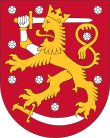 |
| State |
Executive
|
| Legislative |
| Judiciary |
| Recent elections |
| Political parties |
Administrative divisions
|
Foreign relations
|

The Constitution of Finland defines the political system. Finland is a representative democracy with a semi-presidential parliamentary system. Aside from state-level politics, residents use their vote in municipal elections and in the European Union elections.
According to the Constitution, the President of Finland is the head of state and responsible for foreign policy (which excludes affairs related to the European Union) in cooperation with the cabinet. Other powers include Commander-in-Chief, decree, and appointive powers. Direct vote is used to elect the president for a term of six years and maximum two consecutive terms. The current president is Tarja Halonen (SDP).
The 200-member unicameral Parliament of Finland exercises the supreme legislative authority in Finland. The parliament may alter laws and the constitution, bring about the resignation of the Council of State, and override presidential vetoes. Its acts are not subject to judicial review. Various parliament committees listen to experts and prepare legislation. Proportional vote in multi-seat constituencies is used to elect the parliament for a term of four years. The Speaker of Parliament is currently Sauli Niinistö (National Coalition Party). The cabinet (the Finnish Council of State) exercises most executive powers. It is headed by the Prime Minister of Finland and includes other ministers and the Chancellor of Justice. Parliament majority decides its composition, and a vote of no confidence can be used to modify it. The current prime minister is Mari Kiviniemi (Centre Party).
Since equal and common suffrage was introduced in 1906, the parliament has been dominated by the Centre Party (former Agrarian Union), National Coalition Party and Social Democrats, which have approximately equal support and represent 65–80% of voters. After 1944 Communists were a factor to consider for a few decades. The relative strengths of the parties vary only slightly in the elections because of the proportional election from multi-member districts, but there are some visible long-term trends. The autonomous Åland islands has separate elections, where Liberals for Åland was the largest party in 2007 elections.
After the parliamentary elections on March 18, 2007, the seats were divided among eight parties as follows:
| Party | Seats | Net gain/loss | % of seats | % of votes |
|---|---|---|---|---|
| Centre Party | 51 | –4 |
25.5 | 23.1 |
| National Coalition Party | 50 | +10 |
25.0 | 22.3 |
| Social Democratic Party | 45 | –8 |
22.5 | 21.4 |
| Left Alliance | 17 | –2 |
8.5 | 8.8 |
| Green League | 14 | +1 |
7.5 | 8.5 |
| Swedish People's Party | 9 | +1 |
4.5 | 4.5 |
| Christian Democrats | 7 | 0 |
3.5 | 4.9 |
| True Finns | 5 | +2 |
2.5 | 4.1 |
| Others | 1* | 0 |
0.5 | 2.4 |
| * Province of Åland representative. | ||||
Foreign relations
Main article: Foreign relations of FinlandAccording to the latest constitution of 2000, the president (currently Tarja Halonen) leads foreign policy in cooperation with the government (currently Prime Minister Mari Kiviniemi and Foreign Minister Alexander Stubb), except that the government leads EU affairs.
In 2008, President Martti Ahtisaari was awarded the Nobel Peace Prize. Finland was considered a cooperative model state, and Finland did not oppose proposals for a common EU defence policy. This was reversed in the 2000s, when Tarja Halonen and Erkki Tuomioja made Finland's official policy to resist other EU members' plans for common defense.
Geography
Main article: Geography of Finland See also: List of cities and towns in Finland, List of lakes in Finland, and List of national parks of FinlandTopography and geology
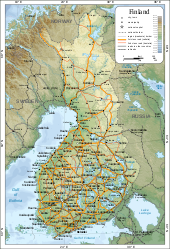
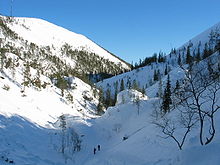

Finland is a country of thousands of lakes and islands – 187,888 lakes (larger than 500 m (0.12 acres)) and 179,584 islands. Its largest lake, Saimaa, is the fourth largest in Europe. The Finnish landscape is mostly flat with few hills, and its highest point, the Halti at 1,324 metres (4,344 ft), is found in the extreme north of Lapland at the border between Finland and Norway.
The landscape is covered mostly (seventy-five percent of land area) by coniferous taiga forests and fens, with little arable land. The most common type of rock is granite. It is a ubiquitous part of the scenery, visible wherever there is no soil cover. Moraine or till is the most common type of soil, covered by a thin layer of humus of biological origin. Podzol profile development is seen in most forest soils except where drainage is poor. Gleysols and peat bogs occupy poorly drained areas. The greater part of the islands are found in the southwest in the Archipelago Sea, part of the archipelago of the Åland Islands, and along the southern coast in the Gulf of Finland.
Finland is one of the few countries in the world whose surface area is still expanding. Owing to the post-glacial rebound that has been taking place since the last ice age, the surface area of the country is expanding by about Template:Km2 to mi2 annually.
The distance from the southernmost – Hanko – to the northernmost point in the country – Nuorgam – is Template:Km to mi.
Wildlife
Main article: Fauna of Finland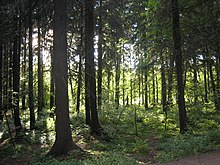
Phytogeographically, Finland is shared between the Arctic, central European and northern European provinces of the Circumboreal Region within the Boreal Kingdom. According to the WWF, the territory of Finland can be subdivided into three ecoregions: the Scandinavian and Russian taiga, Sarmatic mixed forests and Scandinavian Montane Birch forest and grasslands.
Similarly, Finland has a diverse and extensive range of fauna. There are at least sixty native mammalian species, 248 breeding bird species, over seventy fish species and eleven reptile and frog species present today, many migrating from neighboring countries thousands of years ago.

Large and widely recognized wildlife mammals found in Finland are the brown bear (the national animal), gray wolf, wolverine, elk (moose) and reindeer. Three of the more striking birds are the Whooper Swan, a large European swan and the national bird of Finland, the Capercaillie, a large, black-plumaged member of the grouse family and the European Eagle Owl. The latter is considered an indicator of old-growth forest connectivity, and has been declining because of landscape fragmentation. The most common breeding birds are the willow warbler, chaffinch and redwing. Of some seventy species of freshwater fish, the northern pike, perch and others are plentiful. Atlantic salmon remains the favorite of fly rod enthusiasts.
The endangered Saimaa Ringed Seal, one of only three lake seal species in the world, exists only in the Saimaa lake system of southeastern Finland, down to only 300 seals today. It has become the emblem of the Finnish Association for Nature Conservation.
Climate
See also: Climate of Finland
The Finnish climate is suitable for grain farming in the southernmost regions but not further north.
Finland has a humid and cool semi continental climate. The climate type in southern Finland is north temperate climate. Winters of southern Finland (average day time temperature is below 0 °C (32 °F)) are usually 4 months long, and the snow typically covers the land from middle of December to early April. In the southern coast, it can melt many times during early winter, and then come again. The coldest winter days of southern Finland are usually under −20 °C (−4 °F), and the warmest days of July and early August can be over 30 °C (86 °F). Summers in the southern Finland lasts 4 months (from the mid of May to mid of September). In northern Finland, particularly in Lapland, a subarctic climate dominates, characterized by cold – occasionally severe – winters and relatively warm, short summers. Winters in north Finland are nearly 7 months long, and snow covers the lands almost 6 months, from October to early May. Summers in the north are quite short, only 2–3 months.
The main factor influencing Finland's climate is the country's geographical position between the 60th and 70th northern parallels in the Eurasian continent's coastal zone, which shows characteristics of both a maritime and a continental climate, depending on the direction of air flow. Finland is near enough to the Atlantic Ocean to be continuously warmed by the Gulf Stream, which explains the unusually warm climate considering the absolute latitude.
A quarter of Finland's territory lies within the Arctic Circle and the midnight sun can be experienced – for more days, the farther north one travels. At Finland's northernmost point, the sun does not set for 73 consecutive days during summer, and does not rise at all for 51 days during winter.
 Lake Pielinen seen from a hill in Koli National Park.
Lake Pielinen seen from a hill in Koli National Park.
Demographics
Main article: Demographics of Finland| Year | Population | Year | Population |
|---|---|---|---|
| 1750 | 421,000 | 1880 | 2,060,800 |
| 1760 | 491,000 | 1890 | 2,380,100 |
| 1770 | 561,000 | 1900 | 2,655,900 |
| 1780 | 663,000 | 1910 | 2,943,400 |
| 1790 | 705,600 | 1920 | 3,147,600 |
| 1800 | 832,700 | 1930 | 3,462,700 |
| 1810 | 863,300 | 1940 | 3,695,617 |
| 1820 | 1,177,500 | 1950 | 4,029,803 |
| 1830 | 1,372,100 | 1960 | 4,446,222 |
| 1840 | 1,445,600 | 1970 | 4,598,336 |
| 1850 | 1,636,900 | 1980 | 4,787,778 |
| 1860 | 1,746,700 | 1990 | 4,998,478 |
| 1870 | 1,768,800 | 2000 | 5,181,000 |
Population
Finland currently numbers 5,350,156 inhabitants. It has an average population density of 17 inhabitants per square kilometre. This makes it, after Norway and Iceland, the third most sparsely populated country in Europe. Finland's population has always been concentrated in the southern parts of the country, a phenomenon even more pronounced after 20th century urbanisation. The largest and most important cities in Finland are the cities of the Greater Helsinki metropolitan area – Helsinki, Espoo and Vantaa. Other large cities include Tampere, Turku and Oulu.
The share of foreign citizens in Finland is 2.5%, among the lowest in the European Union. Most of them are from Russia, Estonia and Sweden.
Languages
Main articles: Finnish language, Finland Swedish, and Languages of FinlandThe native language of most of the population is Finnish, which is part of the Finno-Ugric language family and is most closely related to Estonian. The language is one of only four official EU languages not of Indo-European origin. The second official language of Finland – Swedish – is the native language of 5.5% of the population. Most of the Finnish people (92%) speak Finnish as their primary language. Finnish is a member of the Baltic-Finnic subgroup of the Uralic languages.
The largest minority language and the second official language is Swedish spoken by 5.6% of the population. Other minority languages are Russian (0.8%), Estonian (0.3%), Finnish Romani and Finnish Sign Language (used as a first language by 4,000–5,000 people). To the north, in Lapland, are also the Sami people, numbering around 7,000 and recognized as an indigenous people. About a quarter of them speak a Sami language as their mother language. There are three Sami languages that are spoken in Finland: Northern Sami, Inari Sami and Skolt Sami. The right of minority groups (in particular Sami, Swedish-speaking Finns and Romani people) to cherish their culture and language is protected by the constitution.
Religion
Main article: Religion in Finland| Religion in Finland | |||||||||||
| year | Evangelical Lutheran Church of Finland | Finnish Orthodox Church | Other | Not religious | |||||||
|---|---|---|---|---|---|---|---|---|---|---|---|
| 1950 | 95.7% | 1.7% | 0.4% | 2.7% | |||||||
| 1980 | 90.3% | 1.1% | 0.7% | 7.8% | |||||||
| 1990 | 87.9% | 1.1% | 0.9% | 10.2% | |||||||
| 2000 | 85.1% | 1.1% | 1.1% | 12.7% | |||||||
| 2005 | 83.1% | 1.1% | 1.1% | 14.7% | |||||||
| 2006 | 82.5% | 1.1% | 1.2% | 15.1% | |||||||
| 2007 | 81.8% | 1.1% | 1.2% | 15.9% | |||||||
| 2008 | 80.7% | 1.1% | 1.3% | 16.9% | |||||||
| 2009 | 79.7% | 1.1% | 1.3% | 17,7% | |||||||
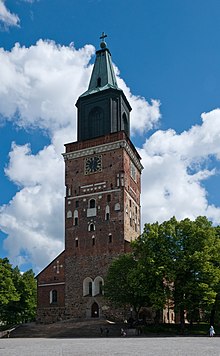
Most Finns are members of the Evangelical Lutheran Church of Finland (79.7%). With approximately 4.3 million members, the Evangelical Lutheran Church of Finland is one of the largest Lutheran churches in the world, although its membership has recently been on the decline. The second largest group - and a rather quickly growing one - of 17.7% of the population has no religious affiliation. A small minority belong to the Finnish Orthodox Church (1.1%). Other Protestant denominations and the Roman Catholic Church in Finland are significantly smaller, as are the Muslim, Jewish and other non-Christian communities (totaling 1.3%).
The main Lutheran and Orthodox churches are constitutional national churches of Finland with special roles such as in state ceremonies and schools.
Most Finnish children are baptized (79,9% in 2009) and confirmed (87.6% in 2008) at the age of 15, and nearly all funerals are Christian. However, the majority of Lutherans attend church only for special occasions like Christmas ceremonies, weddings and funerals. The Lutheran Church estimates that approximately 2 percent of its members attend church services weekly. The average number of church visits per year by church members is approximately two According to a 2005 Eurobarometer poll, 41% of Finnish citizens responded that "they believe there is a God"; 41% answered that "they believe there is some sort of spirit or life force"; and 16% that "they do not believe there is any sort of spirit, God, or life force".
Family structure
Finnish family life is centered on the nuclear family. Relations with the extended family are often rather distant, and Finnish people do not form politically significant clans, tribes or similar structures. According to UNICEF, Finland ranks fourth in the world in child well-being.
Health
Main article: Health in FinlandFinland maintains a high level of health care and standard of living. Life expectancy is 82 years for women and 75 years for men.
Administrative divisions
| This article needs to be updated. Please help update this article to reflect recent events or newly available information. (April 2010) |

Thin borders refer to municipalities and thicker ones to regions.
The fundamental administrative divisions of the country are the municipalities, which may also call themselves towns or cities. They account for half of public spending. Spending is financed by municipal income tax, state subsidies, and other revenue. There are 342 municipalities, and most have fewer than 6,000 residents. People often identify with their municipality.
In addition to municipalities, two intermediate levels are defined. Municipalities co-operate in seventy-four sub-regions and twenty regions. These are governed by the member municipalities but have only limited powers. The Åland region has a permanent democratically elected regional council as a part of the autonomy. In the Kainuu region, there is a pilot project underway with regional elections. Sami people have a semi-autonomous Sami Domicile Area in Lapland for issues on language and culture.
In the following chart, the number of inhabitants includes those living in the entire municipality (kunta/kommun), not just in the built-up area. The land area is given in km², and the density in inhabitants per km² (land area). The figures are as of Error: Invalid time.. The capital region — comprising Helsinki, Vantaa, Espoo and Kauniainen— forms a continuous conurbation of one million people. However, common administration is limited to voluntary cooperation of all municipalities, e.g. in Helsinki Metropolitan Area Council.
List of Finnish municipalities, List of Finnish municipalities by population, List of Finnish municipalities by area, and Former municipalities of FinlandLaw
Main article: Judicial system of FinlandThe judicial system of Finland is a civil law system divided between courts with regular civil and criminal jurisdiction and administrative courts with jurisdiction over litigation between individuals and the public administration. Finnish law is codified and based on Swedish law and in a wider sense, civil law or Roman law. The court system for civil and criminal jurisdiction consists of local courts (käräjäoikeus), regional appellate courts (hovioikeus), and the Supreme Court (korkein oikeus). The administrative branch of justice consists of administrative courts (hallinto-oikeus) and the Supreme Administrative Court (korkein hallinto-oikeus). In addition to the regular courts, there are a few special courts in certain branches of administration. There is also a High Court of Impeachment for criminal charges against certain high-ranking officeholders.
Around 92% of residents are confident in Finland's security institutions. The overall crime rate of Finland is not high in the EU context. Some crime types are above average, notably the highest homicide rate in Western Europe. Crime is prevalent among lower educational groups and is often committed by intoxicated persons. A day fine system is in effect and also applied to offences such as speeding.
Finland has successfully fought against the corruption which was larger in the 1970s and 1980s. For instance, economic reforms and EU membership introduced stricter requirements for open bidding and many public monopolies were abolished. Today Finland has a very low number of corruption charges; Transparency International ranks Finland as one of the least corrupted countries. Also, Finland's public records are among the world's most transparent.
Military
Main articles: Finnish Defence Forces and Military history of Finland See also: List of Finnish wars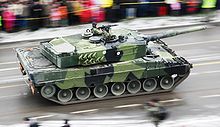


The Finnish Defence Forces consists of a cadre of professional soldiers (mainly officers and technical personnel), currently serving conscripts and a large reserve. The standard readiness strength is 34,700 people in uniform, of which 25% are professional soldiers. A universal male conscription is in place, under which all male Finnish nationals above 18 years of age serve for 6 to 12 months of armed service or 12 months of civilian (non-armed) service.
Alternative non-military service and volunteer service by women (chosen by around 500 annually) are possible. Finland is the only non-NATO EU country bordering Russia. Finland's official policy states that the 350,000 reservists, armed mostly with ground weaponry are a sufficient deterrent.
The Finnish Defense Forces favor partnerships with Western institutions such as NATO, WEU and the EU, but are careful to avoid politics. Finland's defence budget equals about €2 billion or about 1.4–1.6% of the GDP. Finnish defense expenditure is around the third highest in the EU. Voluntary overseas service is popular, and troops serve around the world in UN, NATO and EU peace-keeping missions. Residents claim around 80% homeland defense willingness, one of the highest rates in Europe.
The Finnish Defence Forces are under the command of the Chief of Defence (currently Ari Puheloinen), who is directly subordinate to the President of the Republic in matters related to military command. The branches of the military are the Finnish Army, Finnish Navy and Finnish Air Force. The Border Guard is under the Ministry of the Interior but can be incorporated into the Defence Forces when required for defence readiness.
Economy
Main article: Economy of Finland See also: List of Finnish companies and Helsinki Stock Exchange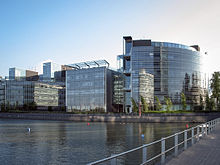
Finland has a highly industrialized free-market economy with a per capita output equal to that of other European economies such as France, Germany, Belgium or the UK. The largest sector of the economy is services at 65.7%, followed by manufacturing and refining at 31.4%. Primary production is 2.9%. With respect to foreign trade, the key economic sector is manufacturing. The largest industries are electronics (21.6%), machinery, vehicles and other engineered metal products (21.1%), forest industry (13.1%) and chemicals (10.9%).
Finland has timber and several mineral and freshwater resources. Forestry, paper factories, and the agricultural sector (on which taxpayers spend around 3 billion euros annually) are politically sensitive to rural residents. The Greater Helsinki area generates around a third of GDP. In a 2004 OECD comparison, high-technology manufacturing in Finland ranked second largest after Ireland. Knowledge-intensive services have also ranked the smallest and slow-growth sectors – especially agriculture and low-technology manufacturing – second largest after Ireland. Overall short-term outlook was good, and GDP growth has been above many EU peers.
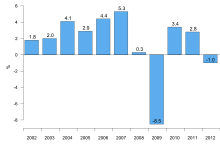
Finland is highly integrated in the global economy, and international trade is a third of GDP. The European Union makes 60% of the total trade. The largest trade flows are with Germany, Russia, Sweden, United Kingdom, United States, Netherlands and China. Trade policy is managed by the European Union, where Finland has traditionally been among the free trade supporters, except for agriculture. Finland is the only Nordic country to have joined the Eurozone.
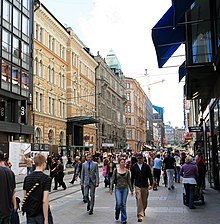

Private sector employees amount to 1.8 million, out of which around a third with tertiary education. The average cost of a private sector employee per hour was 25.1 euros in 2004. As of 2008 average purchasing power-adjusted income levels are similar to those of Italy, Sweden, Germany and France. In 2006, 62% of the workforce worked for enterprises with less than 250 employees and they accounted for 49% of total business turnover and had the strongest rate of growth . The female employment rate is high. Gender segregation between male-dominated professions and female-dominated professions is higher than in the US. The proportion of part-time workers was one of the lowest in OECD in 1999.
Employment rate 68% and unemployment rate was 6.8% in early 2008. 18% of residents are outside job market at the age of 50 and less than a third working at the age of 61. Unfunded pensions and other promises such as health insurances are a dominant future liability, though Finland is much better prepared than countries such as France or Germany. Directly held public debt has been reduced to around 32% of GDP in 2007. In 2007, the average household savings rate was -3.8 and household debt 101% of annual disposable income, a typical level in Europe. Home ownership rate is 60%.
As of 2006, 2.4 million households reside in Finland. The average size is 2.1 persons; 40% of households consist of a single person, 32% two persons and 28% three or more persons. Residential buildings total 1.2 million and the average residential space is 38 m per person. The average residential property without land costs 1,187 euro per sq metre and residential land 8.6 euro per sq metre. 74% of households had a car. There are 2.5 million cars and 0.4 million other vehicles.
Around 92% have a mobile phone and 83.5% (2009) Internet connection at home. The average total household consumption was 20,000 euro, out of which housing consisted of about 5500 euro, transport about 3000 euro, food and beverages excluding alcoholic at around 2500 euro, recreation and culture at around 2000 euro. Purchasing power-adjusted average household consumption is about the same level as it is in Germany, Sweden and Italy. According to Invest in Finland, private consumption grew by 3% in 2006 and consumer trends included durables, high quality products, and spending on well-being.
Education and science
Main article: Education in Finland See also: List of universities in Finland
Most pre-tertiary education is arranged at municipal level. Even though many or most schools were started as private schools, today only around 3% students are enrolled in private schools (mostly Helsinki-based schools such as SYK), many times less than in Sweden and most other developed countries. Pre-school education is rare compared to other EU countries. Formal education is usually started at the age of 7. The primary school takes normally 6 years, the lower secondary school 3 years, and most schools are managed by municipal officials.
The flexible curriculum is set by the Ministry of Education and the Education Board. Attendance is compulsory between the ages of 7 and 16. After lower secondary school, graduates may either enter the workforce directly, or apply to trade schools or gymnasiums (upper secondary schools). Trade schools prepare for professions. Academically oriented gymnasiums have higher entrance requirements and specifically prepare for Abitur and tertiary education. Graduation from either formally qualifies for tertiary education.
In tertiary education, two mostly separate and non-interoperating sectors are found: the profession-oriented polytechnics and the research-oriented universities. Finns used to take student loans and scholarships, but for the past decades the financial risk has been moved solely to the government. There are 20 universities and 30 polytechnics in the country. Helsinki University is 108 in the Top University Ranking of 2009. The World Economic Forum ranks Finland's tertiary education #1 in the world. Around 33% of residents have a tertiary degree, similar to Nordics and more than in most other OECD countries except Canada (44%), United States (38%) and Japan(37%). The proportion of foreign students is 3% of all tertiary enrolments, one of the lowest in OECD, while in advanced programs it is 7.3%, still below OECD average 16.5%.
More than 30% of tertiary graduates are in science-related fields. Finnish researchers are leading contributors to such fields as forest improvement, new materials, the environment, neural networks, low-temperature physics, brain research, biotechnology, genetic technology and communications.
Finland is highly productive in scientific research. In 2005, Finland had the fourth most scientific publications per capita of the OECD countries. In 2007, 1801 patents were filed in Finland.
Energy
See also: Nordic energy market and Nuclear power in Finland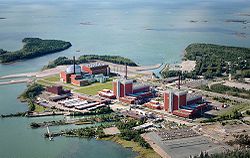
Anyone can enter the free and largely privately owned financial and physical Nordic energy markets traded in Nord Pool and Nord Pool Spot exchanges, which have provided competitive prices compared to other EU countries. As of 2007, Finland has roughly the lowest industrial electricity prices in the EU-15 (equal to France).
In 2006, the energy market was around 90 terawatt hours and the peak demand around 15 gigawatts in winter. This means that the energy consumption per capita is around 7.2 tons of oil equivalent per year. Industry and construction consumed 51% of total consumption, a relatively high figure reflecting Finland's industries. Finland's hydrocarbon resources are limited to peat and wood. Finland has little hydropower capacity compared to Sweden or Norway. Most energy demand is satisfied with fossil fuels such as coal, oil and natural gas.
Finland has four privately owned nuclear reactors producing 18% of the country's energy, one research reactor in Otaniemi campus, and the fifth AREVA-Siemens-built reactor – the world's largest at 1600 MWe and a focal point of Europe's nuclear industry – is scheduled to be operational by 2011. Renewable energy forms (industry-burned wood, consumer-burned wood, peat, industrial residue, garbage) make high 25% compared to the EU average 10%. A varying amount (5–17%) of electricity has been imported from Russia (at around 3 gigawatt power line capacity), Sweden and Norway.
A new submarine power cable from Russia has been considered a national security issue, and one permit application has already been rejected. Finland negotiated itself expensive Kyoto and EU emission terms. They are causing a sharp increase in energy prices and 1-2 billion euro annual cost, amplified by the aging and soon decommissioned production capacity. Energy companies are ready to increase nuclear power production, if parliament granted permits for new reactors.
Transportation
Main article: Transport in Finland
The extensive road system is utilized by most internal cargo and passenger traffic. The annual road network expenditure of around 1 billion euro is paid with vehicle and fuel taxes which amount to around 1.5 billion euro and 1 billion euro.

The main international passenger gateway is Helsinki-Vantaa Airport with over 13 million passengers in 2008. Oulu Airport is the second largest and around 25 airports have scheduled passenger services. The Helsinki-Vantaa based Finnair, Blue1 and Finncomm Airlines sell air services both domestically and internationally. Helsinki has an optimal location for great circle routes between Western Europe and the Far East. Despite low population density, the Government spends annually around 350 million euro in maintaining 5,865 kilometres (3,644 mi) railway tracks even to many rural towns. Only one rail company operates in Finland, VR Group, which has 5% passenger market share (out of which 80% are urban trips in Greater Helsinki) and 25% cargo market share. Helsinki has an urban rail network.
The majority of international cargo utilizes ports. Port logistics prices are low. Vuosaari harbour in Helsinki is the largest container port after completion in 2008 and others include Hamina, Hanko, Pori, Rauma, Oulu. There is passenger traffic from Helsinki and Turku, which have ferry connections to Tallinn, Mariehamn and Stockholm. The Helsinki–Tallinn route, one of the busiest passenger sea routes in the world , has also been served by a helicopter line.
Industry
Finland has developed greatly since 1945, when it was a primarily agricultural nation, and created major firms in telecommunications like Nokia, electronics, metalworking, forestry, metrology and climate measurement systems like Vaisala, and construction like Pöyry. Shipbuilding industry is important for the Finnish economy, and the world's biggest cruise ships are built in Finnish shipyards.
Public policy
See also: Nordic modelFinnish politicians have often emulated other Nordics and the Nordic model. Nordics have been free-trading and relatively welcoming to skilled migrants for over a century, though in Finland immigration is relatively new. The level of protection in commodity trade has been low, except for agricultural products.
Finland has top levels of economic freedom in many areas, although there is a heavy tax burden and inflexible job market. Finland is ranked 16th (ninth in Europe) in the 2008 Index of Economic Freedom. Recently, Finland has topped the patents per capita statistics, and overall productivity growth has been strong in areas such as electronics. While the manufacturing sector is thriving, OECD points out that the service sector would benefit substantially from policy improvements. Finland is one of the most fiscally responsible EU countries.
IMD World Competitiveness Yearbook 2007 ranked Finland 17th most competitive. The World Economic Forum 2008 index ranked Finland the 6th most competitive. In both indicators, Finland's performance was next to Germany, and significantly higher than most European countries. In the Business competitiveness index 2007-08 Finland ranked third in the world.
Economists attribute much growth to reforms in the product markets. According to OECD, only four EU-15 countries have less regulated product markets (UK, Ireland, Denmark and Sweden) and only one has less regulated financial markets (Denmark). Nordic countries were pioneers in liberalizing energy, postal, and other markets in Europe. The legal system is clear and business bureaucracy less than most countries. Property rights are well protected and contractual agreements are strictly honored. Finland is rated the 6th least corrupted countries in Corruption perception index. Finland is rated 13th in the Ease of Doing Business Index. It indicates exceptional ease to trade across borders (5th), enforce contracts (7th), and close a business (5th), and exceptional hardship to employ workers (127th) and pay taxes (83rd).
Finnish job market regulation is a remaining example of Nordic neocorporatist model. In the 1990s, Denmark liberalized its job market, Sweden moved to more flexible decentralized contracts, and Finnish trade unions blocked most reforms. Finnish law forces all workers to obey the national contracts that are drafted every few years for each profession and seniority level. The agreement becomes universally enforceable provided that more than 50% of the employees support it, in practice by being a member of a relevant trade union. The unionization rate is high (70%), especially in the middle class (AKAVA – 80%). A lack of a national agreement in an industry is considered an exception. More flexibility is generally recommended by economists for various reasons.
Numismatics
In Finland, the euro was introduced in 2002. As a preparation for this date, the minting of the new euro coins started as early as 1999; this is why the first euro coins from Finland have the year 1999 on them, instead of 2002 like some of the other countries of the Eurozone. Three different designs (one for €2 coin, one for €1 coin and one for the other six coins) were selected for the Finnish coins. In 2007, in order to adopt the new common map like the rest of the Eurozone countries, Finland changed the common side of their coins.
Finland also has a rich collection of collectors' coins, with face value ranging from 5 to 100 euro. These coins are a legacy of an old national practice of minting silver and gold commemorative coins. Unlike normal issues, these coins are not legal tender in all the eurozone; for instance, a €5 Finnish commemorative coin cannot be used in any other country.
Tourism
Main article: Tourism in Finland| This section does not cite any sources. Please help improve this section by adding citations to reliable sources. Unsourced material may be challenged and removed. (April 2010) (Learn how and when to remove this message) |

In 2005, Finnish tourism grossed over €6.7 billion with a five percent increase from the previous year. Much of the sudden growth can be attributed to the globalisation and modernisation of the country as well as a rise in positive publicity and awareness. There are many attractions in Finland which attracted over 4 million visitors in 2005. The Finnish landscape is covered with thick pine forests, rolling hills and complemented with a labyrinth of lakes and inlets. Much of Finland is pristine and virgin as it contains 35 national parks from the Southern shores of the Gulf of Finland to the high fells of Lapland. It is also an urbanised region with many cultural events and activities. Commercial cruises between major coastal and port cities in the Baltic region, including Helsinki, Turku, Tallinn, Stockholm and Travemünde, play a significant role in the local tourism industry. Finland is regarded as the home of Saint Nicholas or Santa Claus, living in the northern Lapland region. Above the Arctic Circle, there is a polar night, a period when the sun does not rise for days or weeks, or even months. Lapland is so far north that the Aurora Borealis, atmospheric fluorescence, is seen regularly in winter.
Outdoor activities range from Nordic skiing, golf, fishing, yachting, lake cruises, hiking, kayaking among many others. At Finland's northernmost point, in the heart of summer, the Sun does not completely set for 73 consecutive days. Wildlife is abundant in Finland. Bird-watching is popular for those fond of flying fauna, however hunting is also popular. Elk, reindeer and hare are all common game in Finland. Olavinlinna in Savonlinna hosts the annual Savonlinna Opera Festival.
Culture
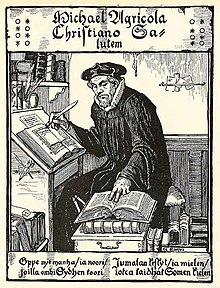
Literature
Main article: Finnish literatureThough Finnish written language could be said to exist since Mikael Agricola translated the New Testament into Finnish in the sixteenth century as a result of the Protestant Reformation, few notable works of literature were written until the nineteenth century, which saw the beginning of a Finnish national Romantic Movement. This prompted Elias Lönnrot to collect Finnish and Karelian folk poetry and arrange and publish them as Kalevala, the Finnish national epic. The era saw a rise of poets and novelists who wrote in Finnish, notably Aleksis Kivi and Eino Leino.
After Finland became independent there was a rise of modernist writers, most famously Mika Waltari. Frans Eemil Sillanpää was awarded the Nobel Prize in Literature in 1939. The second World War prompted a return to more national interests in comparison to a more international line of thought, characterized by Väinö Linna. Literature in modern Finland is in a healthy state. Popular modern writers include Arto Paasilinna, Ilkka Remes, Kari Hotakainen and Jari Tervo, while the best novel is annually awarded the prestigious Finlandia Prize.
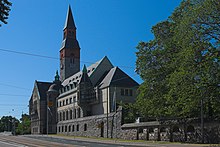
Visual arts
See also: List of Finnish architectsFinns have made major contributions to handicrafts and industrial design. Finland's best-known sculptor of the twentieth century was Wäinö Aaltonen, remembered for his monumental busts and sculptures. Finnish architecture is famous around the world. Among the top of the twentieth century Finnish architects to win international recognition are Eliel Saarinen (designer of the widely recognised Helsinki Central railway station and many other public works) and his son Eero Saarinen. Alvar Aalto, who helped bring functionalist architecture to Finland, is also famous for his work in furniture, textiles and glassware.
Music
Main article: Music of FinlandFolk and Sami music
Main article: Sami musicMuch of the music of Finland is influenced by traditional Karelian melodies and lyrics, as comprised in the Kalevala. Karelian culture is perceived as the purest expression of the Finnic myths and beliefs, less influenced by Germanic influence, in contrast to Finland's position between the East and the West. Finnish folk music has undergone a roots revival in recent decades, and has become a part of popular music.
The people of northern Finland, Sweden and Norway, the Sami, are known primarily for highly spiritual songs called Joik. The same word sometimes refers to lavlu or vuelie songs, though this is technically incorrect.
Classical and opera

The first Finnish opera was written by the German composer Fredrik Pacius in 1852. Pacius also wrote Maamme/Vårt land (Our Country), Finland's national anthem. In the 1890s Finnish nationalism based on the Kalevala spread, and Jean Sibelius became famous for his vocal symphony Kullervo. He soon received a grant to study runo singers in Karelia and continued his rise as the first prominent Finnish musician. In 1899 he composed Finlandia, which played its important role in Finland gaining independence. He remains one of Finland's most popular national figures and is a symbol of the nation.
Today, Finland has a very lively classical music scene. Finnish classical music has only existed for about a hundred years, and many of the important composers are still alive, such as Magnus Lindberg, Kaija Saariaho, Aulis Sallinen and Einojuhani Rautavaara. The composers are accompanied with a large number of great conductors such as Sakari Oramo, Mikko Franck, Esa-Pekka Salonen, Osmo Vänskä, Jukka-Pekka Saraste, Susanna Mälkki and Leif Segerstam. Some of the internationally acclaimed Finnish classical musicians are Karita Mattila, Soile Isokoski, Kari Kriikku, Pekka Kuusisto, Réka Szilvay and Linda Brava.
Popular music
Modern Finnish popular music includes a number of prominent rock bands, jazz musicians, hip hop performers, and dance music acts such as HIM, Bomfunk MCs and Darude. Finnish electronic music such as the Sähkö Recordings record label enjoys underground acclaim. Iskelmä (coined directly from the German word Schlager, meaning hit) is a traditional Finnish word for a light popular song.
Finnish popular music also includes various kinds of dance music; tango, a style of Argentine music, is also popular. One of the most productive composers of popular music was Toivo Kärki, and the most famous singer Olavi Virta (1915–1972). Among the lyricists, Sauvo Puhtila (born 1928), Reino Helismaa (1913–1965) and Veikko "Vexi" Salmi are the most remarkable authors. The composer and bandleader Jimi Tenor is well known for his brand of retro-funk music.
Dance and rock music
Main article: Finnish rock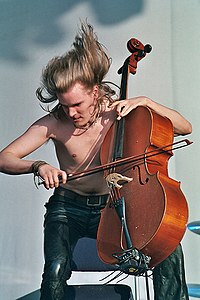
Notable Finnish dance and electronic music artists include Jori Hulkkonen, Darude, JS16, DJ Proteus and DJ Orkidea.
The Finnish rock-music scene emerged in 1960s with pioneers such as Blues Section and Kirka. In the 1970s Finnish rock musicians, such as Juice Leskinen, and a pop rock group called Kaseva started to write their own music instead of translating international hits into Finnish. During the decade some progressive rock groups, such as Tasavallan Presidentti and Wigwam, gained respect abroad but failed to make a commercial breakthrough outside Finland. This was also the fate of the rock and roll group Hurriganes. The Finnish punk scene produced some internationally acknowledged names including Terveet Kädet in 1980s. Hanoi Rocks was a pioneering 1980s glam rock act that left perhaps a deeper mark in the history of popular music than any other Finnish group, giving inspiration for Guns N' Roses. HIM is by far Finland's most internationally known band, going gold in the United States with the album Dark Light, and receiving a Grammy nomination in 2008.The band's frontman Ville Valo is one of Finland and Europe's most famous and intriguing entertainers. The band maintains a massive international cult following. Apocalyptica are an internationally famous Finnish group who are most renowned for mixing strings led classical music with classic heavy metal. Primarily the band found fame through covering songs from Metallica but branched out to writing and recording their own material which featured guest vocalists such as Cristina Scabbia of Lacuna Coil and Til Lindemann of Rammstein. When Finland hosted the Eurovision Song Contest in 2007, Apocalyptica was one of the Finnish bands selected to perform during the ceremony as part of a showcase of modern Finnish music. Of note is the increasingly higher number of metal bands, among which Ensiferum, Wintersun and Turisas, that have gained international recognition for their innovative style and quality. Also a very known melodic heavy metal band Nightwish comes from Finland. Another well known metal band is Children of Bodom.
Cinema
Main article: Cinema of Finland See also: List of Finnish filmsIn film industry, notable directors include Aki Kaurismäki, Mauritz Stiller, Spede Pasanen and Hollywood film director and producer Renny Harlin.
Media and communications
See also: Telecommunications in Finland, List of newspapers in Finland, and List of Finnish television stations
Today there are 200 newspapers; 320 popular magazines, 2,100 professional magazines and 67 commercial radio stations, with one nationwide, five national public service radio channels, three digital radio channels. Each year around twelve feature films are made, 12,000 book titles published and 12 million records sold.
Sanoma publishes the newspaper Helsingin Sanomat (the circulation of 412,000 making it the largest newspaper), the tabloid Ilta-Sanomat, the commerce-oriented Taloussanomat, and the television channel Nelonen. The other major publisher Alma Media publishes over thirty magazines, including newspaper Aamulehti, tabloid Iltalehti and commerce-oriented Kauppalehti. Finns, along with other Nordic people and the Japanese, spend the most time in the world reading newspapers.
The National Broadcasting Company YLE has five television channels and 13 radio channels in two national languages. YLE is funded through a mandatory license for television owners and fees for private broadcasters. All TV channels are broadcast digitally, both terrestrially and on cable. The most popular television channel MTV3 and the most popular radio channel Radio Nova are owned by Nordic Broadcasting (Bonnier and Proventus Industrier).
Around 79 percent of the population use the Internet. Finland had around 1.52 million broadband Internet connections by the end of June 2007 or around 287 per 1,000 inhabitants. All Finnish schools and public libraries have Internet connections and computers. Most residents have a mobile phone. It's used mostly for contact and value-added services are rare. In October 2009, Finland's Ministry of Transport and Communications committed to ensuring that every person in Finland will be able to access the internet at a minimum speed of one megabit-per-second beginning July 2010.
Cuisine
Main article: Cuisine of FinlandPublic holidays
Main article: Public holidays in Finland See also: Flag days in Finland
All official holidays in Finland are established by acts of Parliament. The official holidays can be divided into Christian and secular holidays. The main Christian holidays are Christmas, Epiphany, Easter, Ascension Day, Pentecost and All Saints Day. The secular holidays are New Year's Day, May Day, Midsummer Day and the Independence Day. Christmas is the most extensively celebrated holiday: usually at least 23rd to 26 December are holidays. Also in the region of Bothnia (usually referred at the city of Kokkola) there is an celebration called Venetsialaiset, the celebration of water and fire.
Sports
Main article: Sport in Finland
Various sporting events are popular in Finland. Pesäpallo (reminiscent of baseball) is the national sport of Finland, although the most popular sports in Finland in terms of media coverage are Formula One, rallying, ice hockey and football. Finland won the ice-hockey world championship once in 1995. Jari Kurri and Teemu Selänne are the two Finnish-born ice hockey players to have scored 600 goals in their NHL careers.
The Finland national football team has never qualified for a finals tournament of the World Cup or the European Championships. Jari Litmanen, Sami Hyypiä, Antti Niemi, Jussi Jääskeläinen and Mikael Forssell are the most internationally renowned of the Finnish football players. Snowboarding is also very popular in Finland, and there are many Finnish professional snowboarders such as Antti Autti, Heikki Sorsa, Jussi Oksanen, Eero Ettala, Peetu Piiroinen and Joni Malmi.

Relative to its population, Finland has been a top country in the world in automobile racing, measured by international success. Finland has produced three Formula One World Champions – Keke Rosberg (Williams, 1982), Mika Häkkinen (McLaren, 1998 and 1999) and Kimi Räikkönen (Ferrari, 2007). Following Räikkönen's departure from the sport, the only Finnish Formula One driver currently active is Heikki Kovalainen (Lotus). Rosberg's son, Nico Rosberg (Mercedes GP), is also currently driving, but under his mother's German nationality.
Other notable Finnish Grand Prix drivers include Leo Kinnunen, JJ Lehto and Mika Salo. Finland has also produced most of the world's best rally drivers, including the ex-WRC World Champion drivers Marcus Grönholm, Juha Kankkunen, Hannu Mikkola, Tommi Mäkinen, Timo Salonen and Ari Vatanen. The only Finn to have won a road racing World Championship, Jarno Saarinen, was killed in 1973 while racing.
Among winter sports, Finland has been the most successful country in ski jumping, with former ski jumper Matti Nykänen being arguably the best ever in that sport. Most notably, he won five Olympic medals (four gold) and nine World Championships medals (five gold). Among currently active Finnish ski jumpers, Janne Ahonen has been the most successful. Kalle Palander is a well-known alpine skiing winner, who won the World Championship and Crystal Ball (twice, in Kitzbühel). Tanja Poutiainen has won an Olympic silver medal for alpine skiing, as well as multiple FIS World Cup races.
Some of the most outstanding athletes from the past include Hannes Kolehmainen (1890–1966), Paavo Nurmi (1897–1973) and Ville Ritola (1896–1982) who won eighteen gold and seven silver Olympic medals in the 1910s and 1920s.
They are also considered to be the first of a generation of great Finnish middle and long-distance runners (and subsequently, other great Finnish sportsmen) often named the "Flying Finns". Another long-distance runner, Lasse Virén (born 1949), won a total of four gold medals during the 1972 and 1976 Summer Olympics.
Riku Kiri, Jouko Ahola and Janne Virtanen have been the greatest strength athletes in the country, participating in the World's Strongest Man competition between 1993 and 2000.
The 1952 Summer Olympics, officially known as the Games of the XV Olympiad, were held in Helsinki, Finland. Other notable sporting events held in Finland include the 1983 and 2005 World Championships in Athletics, among others.
Some of the most popular recreational sports and activities include floorball, Nordic walking, running, cycling and skiing.
International rankings
Main article: International rankings of Finland| Organization | Survey | Ranking |
|---|---|---|
| Institute for Economics and Peace | Global Peace Index | 9 out of 144 |
| United Nations Development Program | Human Development Index | 12 out of 182 |
| Transparency International | Corruption Perceptions Index | 6 out of 180 |
| World Economic Forum | Global Competitiveness Report | 6 out of 133 |
Template:International rankings of Finland
See also
Main article: Outline of Finland- Lists
- List of bands from Finland
- List of cities and towns in Finland
- List of Finnish companies
- List of Finnish television stations
- List of Finnish wars
- List of Finns
- List of newspapers in Finland
- List of Swedish-speaking Finns
- List of universities in Finland
- History
- Finlandization
- Kansallisbiografia
- Politics
- Foreign relations of Finland
- Gun politics in Finland
- Military of Finland
- Infrastructure
- Communications in Finland
- Crime in Finland
- Education in Finland
- Fire fighting in Finland
- Transport in Finland
- VR Group (Finnish State Railways)
- Culture and sports
- Ethnic issues in Finland
- Football in Finland
- Miscellaneous
- Protected areas of Finland
References
- Notes
- ^ "The current population of Finland". Population Register Center. Retrieved 2009-11-23.
- ^ "Finland". International Monetary Fund. Retrieved 2010-04-21.
- Human Development Report 2009. The United Nations. Retrieved 5 October 2009.
- "Republic of Finland", or "Suomen tasavalta" in Finnish and "Republiken Finland" in Swedish, is the long protocol name, which is however not defined by law. Legislation only recognizes the short name.
- ^ "Local Finland – Front page". Local Finland. Helsinki: The Association of Finnish Local and Regional Authorities. Retrieved 1 January 2010.
- The Failed States Index 2008
- "Finland: World Audit Democracy Profile". WorldAudit.org. Retrieved 2007-06-11.
- "The 2009 Legatum Prosperity Index". Prosperity.com. Retrieved 2010-02-04.
- "National Archives Service, Finland (in English)". Retrieved 2007-01-22.
- Herkules.oulu.fi. People, material, cultur and environment in the north. Proceedings of the 22nd Nordic Archaeological Conference, University of Oulu, 18–23 August 2004 Edited by Vesa-Pekka Herva Gummerus Kirjapaino
- Dr. Pirjo Uino of the National Board of Antiquities for ThisisFinland – Prehistory: The ice recedes — man arrives. Retrieved June 24, 2008.
- History of Finland and the Finnish People from stone age to WWII. Retrieved June 24, 2008.
- Professor Frank Horn of the Northern Institute for Environmental and Minority Law University of Lappland writing for Virtual Finland on National Minorities of Finland. Retrieved June 24, 2008.
- Gardiner, Samuel Rawson, ed. (1910). "Map No. 6: Europe at the death of Charles the Great, 814". A School Atlas of English History (PDF). London: Longmans, Green, and co. Retrieved 2009-12-25.
{{cite book}}: Cite has empty unknown parameter:|month=(help) - Sawyer and Sawyer: Medieval Scandinavia, page 67. University of Minnesota Press, 1993
- History of Finland. Finland chronology
- ^ "Finland and the Swedish Empire". Federal Research Division, Library of Congress.
- ^ Growth and Equity in Finland, World Bank
- Mickelsson, Rauli. Suomen puolueet – Historia, muutos ja nykypäivä. Vastapaino 2007.
- "A Country Study: Finland — The Finnish Civil War". Federal Research Division, Library of Congress. Retrieved 2008-12-11.
- From slash-and-burn fields to post-industrial society – 90 years of change in industrial structure
- "900-Day Siege of Leningrad". St. Lawrence University.
- Nikolai Baryšnikov, Finland and Siege of Leningrad 1941–1944 (Блокада Ленинграда и Финляндия 1941–44), s.3
- "The Legacy of the Siege of Leningrad, 1941–1995". Cambridge University Press.
- Hidden help from across the Atlantic, Helsingin Sanomat
- ^ Population development in independent Finland – greying Baby Boomers
- "People Living with HIV/AIDS (Adults and Children)". GlobalHealthFacts.org. Retrieved 2010-02-04.
- Finnish constitution, Section 93.
- "The Nobel Peace Prize 2008". The Nobel Foundation. Nobelprize.org. Retrieved 2009-05-10.
- ^ "Finland's foreign policy idea" ("Suomen ulkopolitiikan idea"), Risto E. J. Penttilä, 2008
- "Statistics Finland". Retrieved 2007-01-22.
- "Trends in sea level variability". Finnish Institute of Marine Research. 2004-08-24. Retrieved 2007-01-22.
- "Nutritional and genetic adaptation of galliform birds: implications for hand-rearing and restocking". Oulu University Library (2000). Retrieved 2008-05-23.
- "BirdLife Finland". BirdLife International (2004) Birds in Europe: population estimates, trends and conservation status. Cambridge, UK. (BirdLife Conservation Series No. 12). Retrieved 2007-01-22.
- "SOS: Save our seals". this is Finland (Ministry for Foreign Affairs of Finland).
- "Finland's climate".
- Aunesluoma, Juhana (2007). Lukiolaisen yhteiskuntatieto (in Finnish). WSOY. ISBN 9510276278.
{{cite book}}: Unknown parameter|coauthors=ignored (|author=suggested) (help) - ^ "Population (Foreigners in Finland)". Statistics Finland. Retrieved 2007-06-11.
- ^ "The population of Finland in 2006". Statistics Finland. 2006-12-31. Retrieved 2007-09-04.
- ^ "Population". Statistics Finland. Retrieved 2007-05-07. Cite error: The named reference "Population" was defined multiple times with different content (see the help page).
- "Forskningscentralen för de inhemska språken — Teckenspråken i Finland" (in Template:Sv icon).
{{cite web}}: CS1 maint: unrecognized language (link) - According to the Finnish Population Registry Center and the Finnish Sami parliament, the Sami population living in Finland was 7,371 in 2003. See Regional division of Sami people in Finland by age in 2003 (in Finnish).
- Unofficial names for Finland in Sami languages are: Suopma (Northern Sami), Suomâ (Inari Sami) and Lää´ddjânnam (Skolt Sami). See Geonames.de
- "The Constitution of Finland, 17 § and 121 §" (PDF). FINLEX Data Bank. Retrieved 2007-09-04.
- Transclusion error: {{En}} is only for use in File namespace. Use {{langx|en}} or {{in lang|en}} instead.Statistics Finland with adherence of the Finnish population by religious communities, 1900, 1950, 1990 and 2000–2009
- ^ Church 2009 member statistics Evangelical Lutheran Church of Finland
- Overview membership 1920–2004
- "Finland in Figures". Statistics Finland. Retrieved 2010-05-31.
- "International Religious Freedom Report 2004". U.S. Department of State. 2004-09-15. Retrieved 2007-01-22..
- "International Religious Freedom Report 2004". U.S. Department of State. 2004-09-15. Retrieved 2007-01-22.
- "Eurobarometer on Social Values, Science and technology 2005 – page 11" (PDF). Retrieved 2007-05-05.
- "Child poverty in perspective: An overview of child weill-being in rich countries" (PDF). UNICEF Innocenti Research Centre. Retrieved 2007-02-14.
- "Finland Life expectancy at birth - Demographics". Indexmundi.com. 2009-09-17. Retrieved 2010-02-04.
- Policing corruption, International Perspectives.
- The Burden of Crime in the EU. Research Report: A Comparative Analysis of the European Crime and Safety Survey (EU ICS) 2005
- ^ The History of Corruption in Central Government By Seppo Tiihonen, International Institute of Administrative Sciences
- Women's voluntary service (in Finnish)
- Hägglund, Gustav. Leijona ja kyyhky.
- Työvoimakustannukset puuttuvat puolustusmenoista , Statistics Finland (in Finnish): Eurostat ranking is 6th. It is 3rd when conscription is accounted.
- Jane's World Armies: Finland
- "Finland in Figures – National Accounts". Statistics Finland. Retrieved 2007-04-26.
- "Finland in Figures – Manufacturing". Statistics Finland. Retrieved 2007-04-26.
- ^ Finland Economy 2004, OECD
- Tehdyn työtunnin hinta 23-27 euroa, Statistics Finland
- ^ Suomalaisten tulot Euroopan keskitasoa. Hyvinvointipalvelut eivät paranna sijoitusta
- Small enterprises grow faster than the big ones
- ^ The Nordic Model of Welfare: A Historical Reappraisal, by Niels Finn Christiansen
- Statistics Finland: Labour Market
- OECD recommends Finland to do more to help older people stay in work
- Ikääntymisen taloudelliset vaikutukset ja niihin varautuminen
- CIA Factbook: Public Debt
- Taloussanomat.fi Template:Fi icon
- Statistics Finland: Transport and Tourism
- Own-account worker households' consumption has grown most in 2001-2006
- Retail growth best in Finland for five years, Invest in Finland
- Summary sheets on education systems in Europe
- "Top University Ranking of 2009: University of Helsinki".
- "The Global Competitiveness Report 2006–2007: Country Highlights". World Economic Forum. Retrieved 2007-01-22.
- Tilastokeskus.fi
- Education at Glance 2007: Finland, OECD
- Kari Sipilä, D.Sc.(Tech)h.c. "A country that innovates". Virtual Finland. Ministry for Foreign Affairs/Department for Communication and Culture/Unit for Promotion and Publications.
- "Scientific publication — Finnish science and technology Information Service" (in Finnish). Research.fi. 2007-11-15. Retrieved 2010-02-04.
- "Patents with numbers — Finnish science and technology Information Service" (in Finnish). Research.fi. 2009-12-08. Retrieved 2010-02-04.
- "Start-up of Finnish EPR pushed back to 2013". world-nuclear-news.org. Retrieved 2010-06-15.
- Electricity prices – industrial users
- Statistics Finland
- Total energy consumption
- "Energy Consumption in 2001" (PDF). Statistics Finland. Retrieved 2007-01-22.
- Päästökaupasta voi tulla miljardilasku teollisuudelle
- Finland to decide on new nuclear reactors in 2010
- "Airport operations" (PDF). Annual report 2008. Vantaa: Finavia. 2009-03-17. Retrieved 28 July 2009.
- Transport and communications ministry – Rail
- ^ The Nordic Model by Torben M. Andersen, Bengt Holmström, Seppo Honkapohja, Sixten Korkman, Hans Tson Söderström, Juhana Vartiainen
- ^ Economic freedom: Finland
- Kilpailuvirasto.fi
- World Competitiveness Yearbook 2007
- "The Global Competitiveness Report 2007-2008". World Economic Forum. Retrieved 2008-10-08.
- Finland economy
- Transparency.org
- Economy Rankings, Doing Business Report 2008, World Bank
- "Media moves". ThisisFINLAND (Ministry for Foreign Affairs of Finland).
- "Circulation Statistics". The Finnish Audit Bureau of Circulations (Levikintarkastus Oy). Retrieved 25 July 2009.
- "Internet used by 79 per cent of the population at the beginning of 2007". Statistics Finland. Retrieved 2007-12-22.
- "Market Review 2/2007" (PDF). Finnish Communications Regulatory Authority (FICORA). 2007-08-31. Retrieved 2007-09-04.
- Information technology has become part of Finns' everyday life, Statistics Finland
- "1Mb Broadband Access Becomes Legal Right". YLE. 2009-10-14. Retrieved 2009-10-16.
- Economicsandpeace.org
- "Vision of Humanity". Vision of Humanity. Retrieved 2010-02-04.
- "Corruption Perceptions Index 2009". Transparency International. 2009. Retrieved 2010-06-01.
Further reading
- Chew, Allen F. The White Death: The Epic of the Soviet-Finnish Winter War (ISBN 0-87013-167-2)
- Engle, Eloise and Paananen, Pauri,The Winter War: The Soviet Attack on Finland 1939-1940 (ISBN 0-8117-2433-6)
- Insight Guide: Finland (ISBN 981-4120-39-1)
- Jakobson, Max. Finland in the New Europe (ISBN 0-275-96372-1)
- Jutikkala, Eino; Pirinen, Kauko. A History of Finland (ISBN 0-88029-260-1)
- Klinge, Matti. Let Us Be Finns: Essays on History (ISBN 951-1-11180-9)
- Lavery, Jason. The History of Finland (The Greenwood Histories of the Modern Nations), Greenwood Press 2006 (ISBN 0-313-32837-4) (ISSN 1096-2905)
- Lewis, Richard D. Finland: Cultural Lone Wolf (ISBN 1-931930-18-X)
- Lonely Planet: Finland (ISBN 1-74059-791-5)
- Mann, Chris. Hitler's Arctic War: The German Campaigns in Norway, Finland, and the USSR 1940-1945 (ISBN 0-312-31100-1)
- Rusama, Jaakko. Ecumenical Growth in Finland. (ISBN 951-693-239-8)
- Singleton, Fred. A Short History of Finland (ISBN 0-521-64701-0)
- Subrenat, Jean-Jacques – Listen, there's music from the forest; a brief presentation of the Kuhmo Chamber Music Festival (ISBN 952-92-0564-3)
- Swallow, Deborah. Culture Shock! Finland: A Guide to Customs and Etiquette (ISBN 1-55868-592-8)
- Trotter, William R.. A Frozen Hell: The Russo-Finnish Winter War of 1939-1940 (ISBN 1-56512-249-6)
External links
- Facts about Finland – with a list of most famous Finns, Finland Facts, Resources, etc.
- this is Finland – things you should and shouldn't know Official portal of Finland (administered by the Ministry for Foreign Affairs of Finland)
- Chief of State and Cabinet Members
- Visit Finland – The official travel and tourism guide by the Finnish Tourist Board
- "Finland". The World Factbook (2025 ed.). Central Intelligence Agency.
- Finland at UCB Libraries GovPubs
- Template:Dmoz
 Wikimedia Atlas of Finland
Wikimedia Atlas of Finland- Template:Wikitravel
Template:Link GA Template:Link GA Template:Link GA Template:Link FA Template:Link FA Template:Link FA
Categories:- Articles that may be too long from January 2010
- Finland
- European countries
- European Union member states
- Countries bordering the Baltic Sea
- Nordic countries
- Republics
- Scandinavia
- Northern Europe
- Liberal democracies
- States and territories established in 1918
- Member states of the Union for the Mediterranean
- Bilingual countries